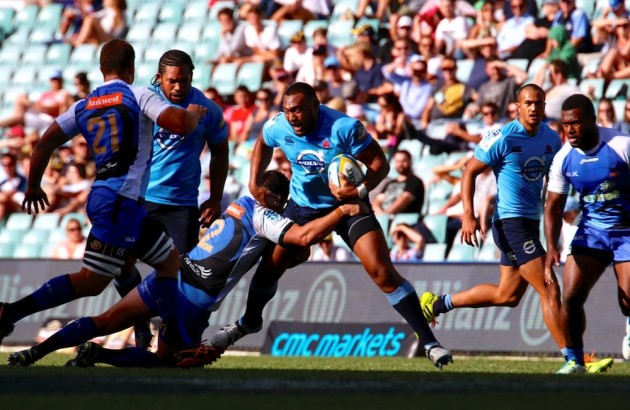Let’s wind the clock back a few months. In the build-up to the autumn Wales-Australia match, the Wales hooker Richard Hibbard had set out Wales’ stall pretty succinctly. He expected a repeat of the 3rd Test between Australia and the Lions:
‘We were physical, we battered them for 60 minutes and that was the end of it, they couldn’t survive after that,’ Hibbard said. ‘We have to bring that ferocity again.’
 The softening-up process had been focused on the scrum and the contact points, and Hibbard was at the heart of both, smashing George Smith in one concussive tackle and helping his loose-head Alex Corbisiero get Ben Alexander yellow-carded after only 24 minutes.
The softening-up process had been focused on the scrum and the contact points, and Hibbard was at the heart of both, smashing George Smith in one concussive tackle and helping his loose-head Alex Corbisiero get Ben Alexander yellow-carded after only 24 minutes.
Ewen McKenzie would therefore have had two priorities at the top of his ‘need to do’ list:
1. To get more physical assertiveness out of his big men in the tight five.
2. Deliver a more aggressive performance from his tight-head prop in the scrum.
Somewhat unexpectedly, he got both of his answers from the same source – Sekope Kepu.
Kepu has been a cause of frustration to Wallaby fans, his mild demeanour at odds with a physical frame more imposing than other Aussie forwards, with the possible exception of Sitaleki Timani.
But if anyone stood up to be counted on the Autumn trip, it was Kepu. McKenzie and his scrum coach Andrew Blades had vented their frustration with scrum interpretations both publicly and privately, and ‘Link’ had even gone so far as to make an official submission to the IRB after the England game:
“It’s down to matters of consistent interpretation I haven’t got my mind around the fact that you can win your own scrum ball cleanly and still get seven penalties against you, and [England] get none. It defies some logic there. It’s a matter of opinion and the guy in the middle is closer to the action but I’m just looking to understand that dynamic. We’ll find out when they get back to me.”
The Wallabies began the tough process of changing the perception of their scrum against one of the most experienced front-rows in Europe – the Irish trio of Cian Healy, Rory Best and Mike Ross. Cian Healy would have been the Lions’ starting loose-head in the summer but for injury. Let’s see how they went about it.
[youtube id=”3R1f-G6v4N4″ width=”600″ height=”350″]
- The first scrum of any game is a key point in imprinting an association in the referee’s subconscious for the rest of the game. At the first set-piece [at 3:33], Australia manage to creep forward after the engagement, and the Irish 9 has to take five quick steps to his right to stay opposite the middle of the tunnel. Although Ireland won a free-kick for pushing through the mark, the Wallabies in fact won a much larger battle in the context of Chris Pollock’s perception of the scrum. The first job of a good tight-head on the opposition feed is to keep the loose-head and hooker unsettled. At that first scrum, Kepu forces Cian Healy to adjust the position of his left foot four times before the ball can be put in, and they are all backward steps.
- At the next scrum on an Ireland feed [14:23], the Wallabies do not do much more than crab laterally across field after the ball is put in, but it is enough to win them the full penalty.
- At the third Irish scrum at 43:30, loose-head James Slipper clearly takes three side-steps to his left enabling the Australian scrum to go through 90 and claim the turnover – a maneuver that often gets penalised for ‘running the scrum around the corner’. But the perception of Wallaby dominance — the seed already planted by Kepu at that very first scrum in the 4th minute – reverses the call in their favour.
- In the early part of the second half, Australia ‘rinse and repeat’ the process from the first period, ensuring that they get a couple of positive forward steps in as the first scrum goes to ground [44:25] before setting an ideal platform for Quade Cooper to score a try from first phase at 45:43.
Kepu’s performance against Wales was even more eye-catching, and perhaps even more surprising. For someone who is usually the biggest man in the forwards at around 125-128kgs, he has always appeared to be something of a shrinking violet when push comes to shove and the confrontations become distinctly Old Testament. That all changed in the Wales match.
- At two consecutive tackle situations in the Wales 22 [11:58 & 18:43], Kepu’s superiority at the point of contact creates a platform for 10 Wallaby points. In the second instance, he puts the Wallabies firmly on the front foot by hurling Richard Hibbard, one of the two Lions 3rd Tests totems, into the Millennium stadium turf. He makes the physical statement that Australia were unable to make in Sydney against the Lions.
- At two situations with some physical ‘afters’, Kepu confronts Alun-Wyn Jones [the other big Lions tight forward from the 3rd Test] and draws a line in the ground, first after a cleanout at 22:29, then in the aftermath of Israel Folau’s try [36:32]. He plays, in other words, as big as his size.
- At two other contact points – the Welsh driving maul at 28:00 and the jackaling contest at 29:26, Kepu shows a previously un-obvious desire to put his head in where it hurts, sacking the maul [twice] and taking a knee in the head for his trouble, then winning a perfectly legitimate turnover at the tackle only to be denied by a dubious penalty decision by ref Wayne Barnes.
No-one did more than Kepu in the autumn series, to reverse the psychological and physical damage of the third Lions Test, and begin the process of overturning the perception of the Wallaby scrum that has existed for as long as anyone can remember… Therefore the decision of Michael Cheika [the Waratahs coach] to start with Paddy Ryan ahead of Kepu in the early stages of the current Super 15 gives rise to a lot of head-scratching.
Has Ryan improved dramatically? Or has Kepu fallen away from his autumn standards in training behind closed doors? Let’s take a look at Ryan’s performance in the recent derby against the Reds…
[youtube id=”http://www.youtube.com/watch?v=yVI_omasaf0&list=UUwASj8YUwKDdnzGCBixJwaw” width=”600″ height=”350″]
Ryan was scrummaging against the Wallaby incumbent no.1 James Slipper until the 44th minute. During that period, of the 10 scrums that packed down,
- Two were penalties against the Tahs front-row [including one on Ryan for angling into the middle of tunnel]
- One was a free-kick against the Tahs for pushing too early
- Two were Reds’ feeds with their tight-head successfully promoting to open up the right side of the field for Genia
- One was a Tahs feed with Ryan under pressure from Slipper
- Three were rock-solid Reds’ put-ins
- One was a free-kick to the Tahs for the Reds pushing too early
So 60% of the first 10 scrums were ‘advantage Reds’, 30% were even and 10% were ‘advantage Tahs’. It was noticeable on the Reds’ feed that Saia Fainga’a was able to stick out his foot to trigger the put-in, indicating how little pressure he was experiencing on the left side of the Reds’ scrum. When Slipper went off and his replacement Ben Daley came on, both Ryan and Kepu gained an immediate advantage in the set-piece.
Ryan’s performance in the open was mixed. On the positive side, Ryan showed some nice handling touches and was part of the turnover hit on Jake Schatz along with Cliff Palu. He is however what is known as a ‘near-side defender’ – a tight forward who is not quick or athletic enough to get around the corner of the first ruck from set-piece, unlike Kepu who can wrap around in defence and also get to the first midfield breakdown as part of the cleanout.
Paddy Ryan is clearly a talented player still relatively early in his development, but that together with my observations above makes me wonder why Paddy is getting the starts ahead of Sekope? Paddy Ryan is a promising player but Kepu was one of Australia’s most improved players and a hidden star in the Autumn.


